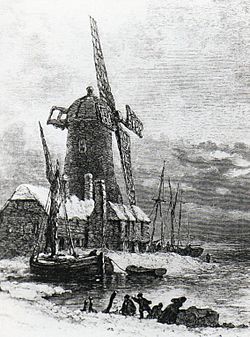Langstone Windmill facts for kids
Quick facts for kids Langstone Windmill |
|
|---|---|

The mill in 1869
|
|
| Origin | |
| Mill name | Langstone Mill |
| Grid reference | SU 7199 0494 |
| Coordinates | 50°50′22″N 0°58′43″W / 50.8395°N 0.9787°W |
| Operator(s) | Private |
| Information | |
| Purpose | Corn mill |
| Type | Tower mill |
| Storeys | Four storeys |
| No. of sails | Four sails |
| Type of sails | Common sails |
| Windshaft | Wood |
| Winding | Hand winded |
Langstone Windmill is a special old building in Langstone, Hampshire, England. It's a type of windmill called a tower mill. Today, it's not used for grinding grain anymore; it has been changed into a home. It is also a Grade II listed building, which means it's an important historical site.
History of the Windmill
Langstone Windmill was built a long time ago, around the year 1730. It used to work together with another type of mill nearby, called a tide mill. A tide mill uses the power of the ocean's tides to work!
By 1934, the windmill was no longer working and was in a very bad state, almost falling apart. But by 1939, it was given a new life! The windmill tower was fixed up and covered with a protective layer, and a new top (called a cap) was built. Since then, it has been used as a house.
What the Windmill Looks Like
Langstone Windmill is a four-storey tower mill. This means it has four main levels inside. It looks like it might have been made taller at some point in its history.
The windmill had a round, dome-shaped top, called a cap. This cap could be turned by hand to face the sails into the wind. It had four common sails, which are a basic type of windmill sail. These sails were attached to a large wooden pole called a windshaft, which would spin when the wind pushed the sails.

